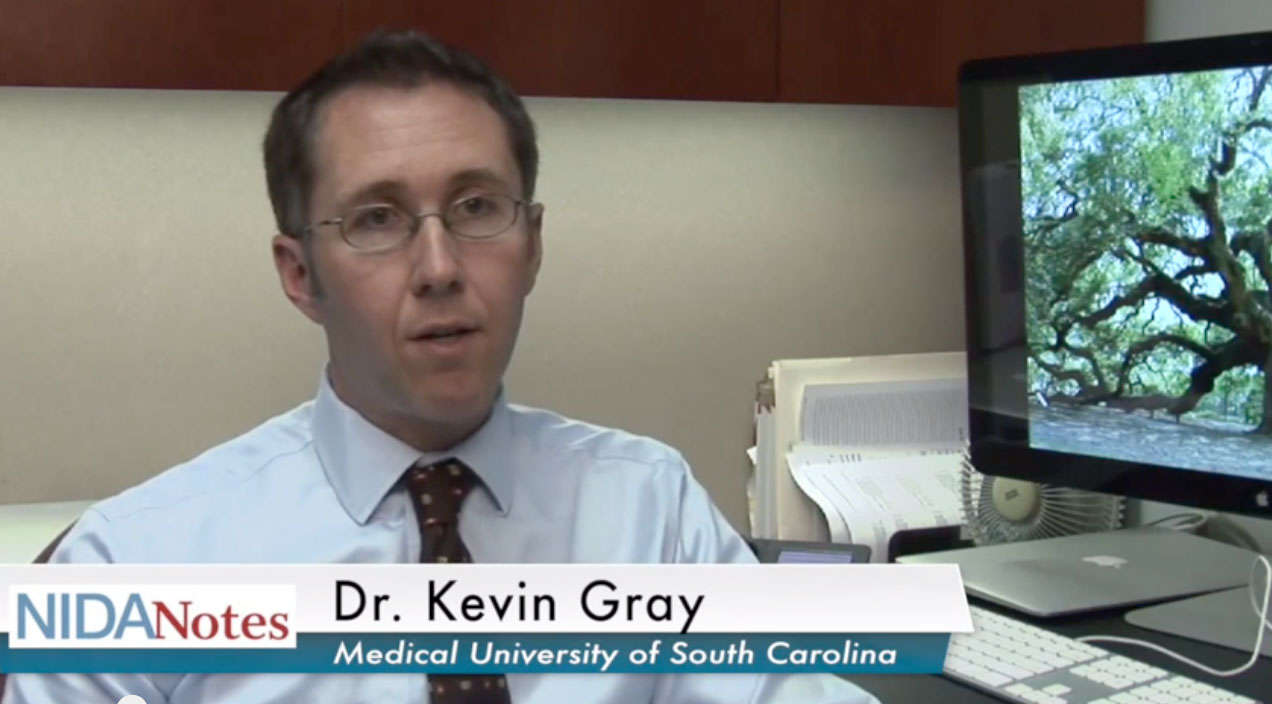Dr. Kevin M. Gray, an associate professor of psychiatry and behavioral sciences at the Medical University of South Carolina, discusses the promise of N-acetylcysteine as a potential treatment for marijuana use and dependence.
 In this podcast, NIDA-funded researcher Dr. Kevin M. Gray describes an ongoing clinical trial examining the possibility of using N-acetylcysteine to treat marijuana addiction.
In this podcast, NIDA-funded researcher Dr. Kevin M. Gray describes an ongoing clinical trial examining the possibility of using N-acetylcysteine to treat marijuana addiction.NIDA Notes: You obtained encouraging results in a trial of N-acetylcysteine (NAC) as an adjunct to behavioral therapy for marijuana use. Should clinicians begin using NAC with patients?
Dr. Gray: I am often asked this question since we reported the results from our trial with marijuana-dependent adolescents in 2012. We found that adding NAC to behavioral therapy increased the adolescents’ likelihood of submitting cannabis-negative urine samples. In addition, the medication has a long history of patient tolerability and safety in clinical use, where it is given to protect the liver in cases of acetaminophen overdose and to clear excess mucous in respiratory disorders, among other purposes. Moreover, NAC is readily available and inexpensive as an over-the-counter nutritional supplement.
For those reasons, I share the enthusiasm of the physicians who inquire about giving NAC to patients who are not doing well with other therapies for marijuana use. However, I would give two caveats. First, in our trial with adolescents, all participants, including those receiving NAC and those receiving placebo, also received contingency management, a behavioral treatment, on a weekly basis. So at this point, we only have evidence that NAC can be effective as an add-on or complementary treatment to an existing evidence-based treatment. My second caveat is that the Food and Drug Administration has not endorsed using NAC to treat substance abuse.
NN: What does NAC do that might explain your promising results?
Dr. Gray: Most of what we know about what makes NAC a good candidate medication for treating substance use disorders is based on animal research conducted here at MUSC under the leadership of Dr. Peter Kalivas. This research has shown that animals that compulsively seek drugs have altered levels of a brain chemical called glutamate in a brain structure called the nucleus accumbens. And the research has shown that administering NAC restores normal glutamate levels in such animals and reduces the likelihood that they will seek a drug, or seek large amounts of it.
NN: What else would you like to learn about NAC?
Dr. Gray: We need to further characterize NAC’s neurochemical and behavioral mechanisms of action in the treatment of drug use. This will help us see where the medication might fit in to overall treatment optimization in evidence-based practice.
As a clue to those mechanisms, we have some evidence that NAC may exert beneficial effects on compulsive behaviors beyond drug use. Dr. Jon Grant’s group at the University of Minnesota and others have looked at NAC as a possible treatment for compulsive gambling, trichotillomania, and other uncontrolled behaviors.
NN: This seems like a particularly apt time to research treatments for marijuana dependence.
Dr. Gray: Yes, although the need for better treatments for marijuana use disorders is not a new development.
Marijuana has attracted a lot of popular interest recently because of the policy changes that have altered its legal status in many states. Numerous misconceptions go along with those changes, including the notion that marijuana use poses no danger. In fact, while many people have benign and brief experiences with this drug, a significant number develop dependence or addiction. About 1 out of 11 adults who use marijuana, and about 1 out of 6 adolescent users, become dependent.
Also contrary to what many people suppose, marijuana can produce physiological dependence. A person who has developed tolerance to the drug and then is deprived of it may experience withdrawal symptoms including cravings, irritability, changes in appetite, and altered sleep. People who regularly use marijuana also often wind up with problems in their daily functioning.
Marijuana use among adolescents has been steadily increasing for the past several years, and is a cause for particular concern. In addition to an elevated likelihood of dependence, heavy marijuana use during adolescence is associated with lasting negative effects on cognition, lower academic performance, reduced occupational functioning, and increased risk for developing psychiatric disorders.
NN: How did you first become interested in studying substance use disorders?
Dr. Gray: In my clinical psychiatry practice, I found that substance abuse was very common among my young patients and very challenging to treat. Marijuana use worsens the course of psychiatric illnesses. We need to find effective ways to address marijuana use and dependence, particularly in people with co-occurring psychiatric illnesses.
